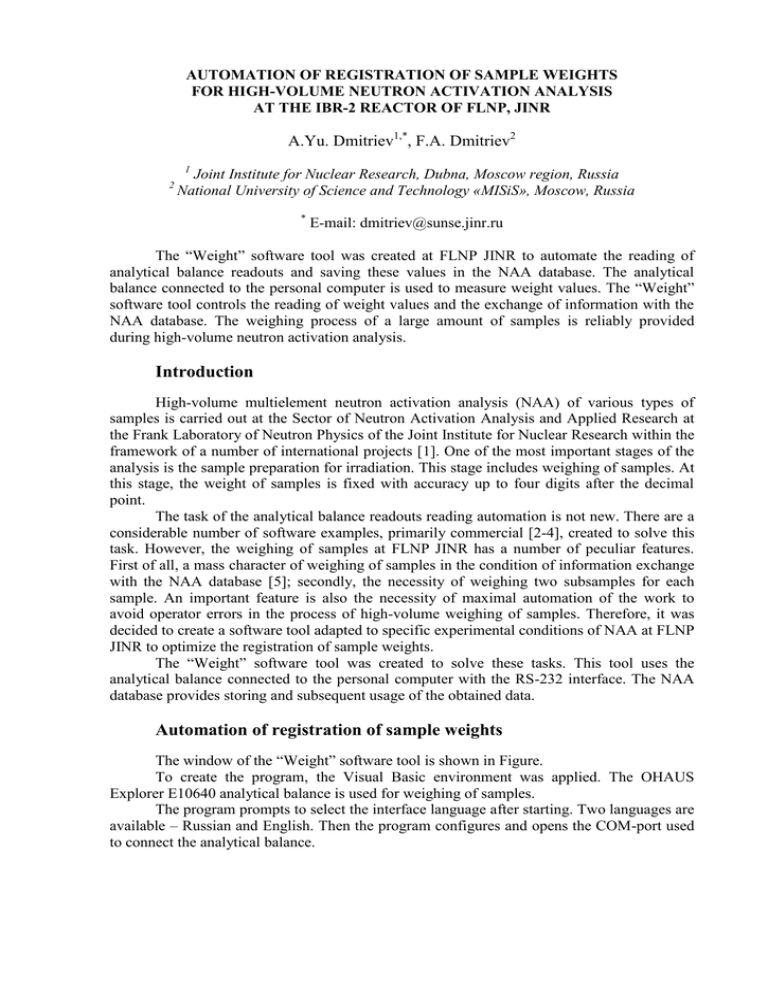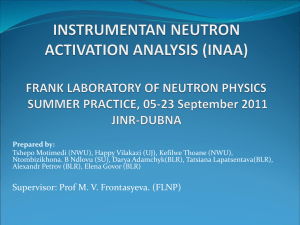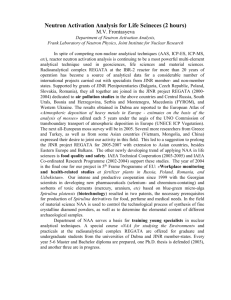Introduction Automation of registration of sample weights
advertisement

AUTOMATION OF REGISTRATION OF SAMPLE WEIGHTS FOR HIGH-VOLUME NEUTRON ACTIVATION ANALYSIS AT THE IBR-2 REACTOR OF FLNP, JINR A.Yu. Dmitriev1,*, F.A. Dmitriev2 1 2 Joint Institute for Nuclear Research, Dubna, Moscow region, Russia National University of Science and Technology «MISiS», Moscow, Russia * E-mail: dmitriev@sunse.jinr.ru The “Weight” software tool was created at FLNP JINR to automate the reading of analytical balance readouts and saving these values in the NAA database. The analytical balance connected to the personal computer is used to measure weight values. The “Weight” software tool controls the reading of weight values and the exchange of information with the NAA database. The weighing process of a large amount of samples is reliably provided during high-volume neutron activation analysis. Introduction High-volume multielement neutron activation analysis (NAA) of various types of samples is carried out at the Sector of Neutron Activation Analysis and Applied Research at the Frank Laboratory of Neutron Physics of the Joint Institute for Nuclear Research within the framework of a number of international projects [1]. One of the most important stages of the analysis is the sample preparation for irradiation. This stage includes weighing of samples. At this stage, the weight of samples is fixed with accuracy up to four digits after the decimal point. The task of the analytical balance readouts reading automation is not new. There are a considerable number of software examples, primarily commercial [2-4], created to solve this task. However, the weighing of samples at FLNP JINR has a number of peculiar features. First of all, a mass character of weighing of samples in the condition of information exchange with the NAA database [5]; secondly, the necessity of weighing two subsamples for each sample. An important feature is also the necessity of maximal automation of the work to avoid operator errors in the process of high-volume weighing of samples. Therefore, it was decided to create a software tool adapted to specific experimental conditions of NAA at FLNP JINR to optimize the registration of sample weights. The “Weight” software tool was created to solve these tasks. This tool uses the analytical balance connected to the personal computer with the RS-232 interface. The NAA database provides storing and subsequent usage of the obtained data. Automation of registration of sample weights The window of the “Weight” software tool is shown in Figure. To create the program, the Visual Basic environment was applied. The OHAUS Explorer E10640 analytical balance is used for weighing of samples. The program prompts to select the interface language after starting. Two languages are available – Russian and English. Then the program configures and opens the COM-port used to connect the analytical balance. The program considers all the essential features of NAA at FLNP JINR: there are groups of elements: “samples”, “standards”, and “monitors” in the program’s window. The program reads lists of sample sets, standard sets, and monitor sets automatically from the NAA database and records these lists in the corresponding tables. Then the experimenter should select one of three options in the “type of measurements” group of elements: “samples”, “standards”, or “monitors”. A group of elements corresponding to the selected option becomes available after this selection. The rest of groups are unavailable. A group of elements called “samples” is available as most requested by default. Next, the experimenter selects the type of analyzed samples: “SLI and LLI” (samples for measurement of short-lived and long-lived isotopes), “SLI” only, or “LLI” only. For the experimenter only the row selection in the table with the list of sample sets is available. After the selection of the required set is done, the program reads the data about the samples from the selected set of the NAA database and fills in the corresponding table for weights. The experimenter can select only individual cells in the table for weight. One needs to select the cell corresponding to the measured sample, place the sample in the analytical balance, wait for stable readouts in the scale, and click the “count and write into the table the weight of the sample” button. As a result of the button clicking, the weight value is read by the program and written into the selected cell. Interface of the “Weight” software tool The created software offers a wide range of possibilities for automation of the weighing process. In addition to automation of information exchange with the NAA database, the program allows the automation of the next cell selection after the weight value entering into the current one. The type of samples determines the selection of the next cell. It may be the cell in the current row in the column of LLI samples, if the measurement type is “SLI and LLI” and the current cell is in the SLI samples column. Otherwise, if the selected type of measurement is either “SLI” only or “LLI” only, it will be the cell in the next row of the selected column. Another possibility of the program is the introduction of the restrictions to prevent erroneous selection of a cell: the program allows one to select a cell in columns for storage of weight values only. In addition, the program monitors the type of measurement and, for example, does not allow selecting a cell in the column corresponding to SLI samples, if LLI sample measurements were selected. An attempt to do this operation will automatically lead to selection of the cell from the LLI column, located in the required row. When the last cell in the last row is reached, the experimenter will be warned about the end of the measurement. A distinctive feature of NAA at JINR is the adherence to the QA/QC procedures. The QA/QC procedures require saving information in different independent locations. In our case, in addition to the NAA database, this is the so-called “file of weights”. After the first sample of the current sample set has been weighed, the program requires the experimenter to specify the name and the location of this file. The results of further work are automatically saved in the selected file. In addition, when the program’s window closes, the experimenter sees the reminding about the necessity of the results saving in the NAA database. The system of commands to manage the analytical balance with the help of the personal computer is provided. The “Weight” software tool uses the “P” command – print displayed weight according to “Stable only” setting – to read the weight value. The program closes the COM-port at the end of the work. There are also some peculiarities during the work with the sets of monitors and standards. In this case, the experimenter can add rows manually, using the “add row” button. The maximum number of samples in any set is 99. If an extra row is added, the experimenter sees the appropriate message. The program automatically generates the necessary SQL queries to work with the NAA database, initiates their execution, as well as organizes the reception and the processing of the feedback. The measured weight values are used by the automation system for measurement of spectra of induced activity [6]. During the spectra measurements the weight values are automatically read from the NAA database and written to the spectra files. The processing of measured spectra is impossible without performing this step. The final stage of the analysis – the calculation of concentrations of elements in the samples – is performed using the “Concentration” program [7]. Acknowledgements. The authors acknowledge IAEA CRP1888 “Development of an Integrated Approach to Routine Automation of Neutron Activation Analysis” [8]. References 1. Frontasyeva M.V. Neutron Activation Analysis for the Life Sciences. A Review // Phys. Part. Nucl. 2011. V. 42, No. 2, P. 332-378. 2. Software WinCT for A&D balances. http://www.aandd.jp/products/weighing/wproduct.html#softwares. 3. Software for OHAUS balances. http://www.ohaus.com/en/home/support/software-and-drivers.aspx. 4. Software for Vesta balances. http://www.okbvesta.ru/. 5. Dmitriev A.Yu., Pavlov S.S. Software for Automation of Neutron Activation Analysis at the IBR-2 Reactor of FLNP, JINR // J. Nucl. Meas. Inform. Techn. 2012. V. 4. P. 54-66 (in Russian). 6. Pavlov S.S., Dmitriev A.Yu., Chepurchenko I.A., Frontasyeva M.V. Automation System for Measurement of Gamma-Ray Spectra of Induced Activity for MultiElement High Volume Neutron Activation Analysis at the Reactor IBR-2 of Frank Laboratory of Neutron Physics at the Joint Institute for Nuclear Research // Part. Nucl., Lett. 2014. V. 11, No. 6(190). P. 1143-1149. 7. Dmitriev A.Yu., Pavlov S.S. Automation of the Quantitative Determination of Elemental Content of Samples Using Neutron Activation Analysis at the IBR-2 Reactor of the Frank Laboratory of Neutron Physics, Joint Institute for Nuclear Research // Part. Nucl., Lett. 2013. V. 10, No. 1(178). P. 58-64 (in Russian). 8. Ridikas D. et al. New Opportunities for the Enhanced NAA Services through the Reactor Coalition and Networks // J. Radioanal. Nucl. Chem. 2012. V. 291. P. 329334.






